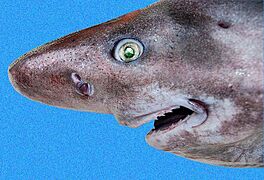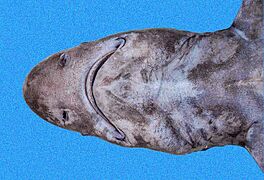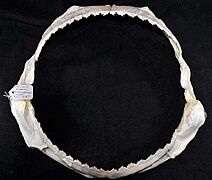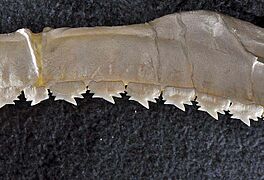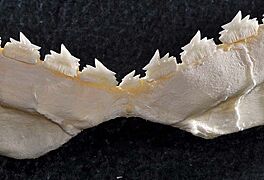Prickly shark facts for kids
Quick facts for kids Prickly shark |
|
|---|---|
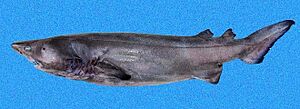 |
|
| Conservation status | |
| Scientific classification | |
| Genus: |
Echinorhinus
|
| Species: |
cookei
|
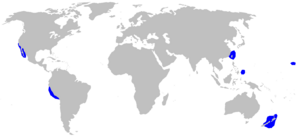 |
|
| Range of the prickly shark | |
The prickly shark (Echinorhinus cookei) is a type of shark that lives in the Pacific Ocean. It is one of only two species in its family, called Echinorhinidae. The other one is the bramble shark.
These sharks usually live deep in the ocean, from about 100 to 650 meters (330 to 2,130 feet) down. They prefer cool waters. Sometimes, they come closer to the surface in places like Monterey Bay in California. The prickly shark is a bottom-dweller, meaning it stays near the sea floor.
This shark is quite stocky and dark-colored. It can grow up to 4 meters (13 feet) long. It has two small fins on its back, placed far back on its body. It does not have an anal fin (a fin on its underside). The shark is covered in many thorn-like bumps on its skin. These bumps are called dermal denticles, and they give the shark its "prickly" name.
Prickly sharks are active at night. They rest in deeper waters during the day. At dusk, they swim up to shallower areas to hunt. Each shark tends to stay in a small area. They eat many different kinds of fish and cephalopods like octopuses and squid. Since they move slowly, they might use suction to catch their food. Female prickly sharks give birth to many live young. This shark is not dangerous to humans. It is sometimes caught by accident by deepwater fishing boats. Because of this, scientists are watching its population.
Contents
What is a Prickly Shark?
The prickly shark was first described by a scientist named Viktor Pietschmann in 1928. He named it after Charles Montague Cooke Jr.. For a while, people confused the prickly shark with the bramble shark. But in 1960, another scientist, Jack Garrick, helped everyone understand they were different. Other names for this shark include Cook's bramble shark and spinous shark.
How to Identify a Prickly Shark
The prickly shark has a soft, round body. Adult sharks are much bigger than young ones. Its head is short and a bit flat. It has tiny breathing holes called spiracles behind its eyes. Its eyes do not have a special eyelid. The shark has a wide mouth with many sharp, knife-like teeth. These teeth have a main point and smaller points on the sides. It has five pairs of gill slits for breathing.
A line runs along each side of its body. This is called the lateral line, and it helps the shark sense movement in the water. Its front fins (pectoral fins) are short. Its back fins (pelvic fins) are quite large. The two fins on its back are small and close together. It does not have an anal fin. The tail fin has a longer upper part and a less clear lower part.
The skin of the prickly shark is covered in many small, thorn-like bumps. These bumps are about 0.4 centimeters (0.16 inches) wide. They are not joined together, unlike those on the bramble shark. Each bump looks like a thorn with ridges. The shark is usually plain brown or gray, sometimes with a purple color. Its fins have black edges. Its belly is lighter, especially around its snout and mouth. This shark can grow up to 4 meters (13 feet) long. The heaviest one ever recorded weighed 266 kilograms (586 pounds).
Where Prickly Sharks Live
Prickly sharks are found all over the Pacific Ocean. In the western Pacific, they live near Japan, Taiwan, Australia, and New Zealand. They are also found around islands like Palau, Hawaii, and Tonga. In the eastern Pacific, they live from Oregon down to El Salvador. They are also found near the Galapagos Islands and off Peru and Chile.
These sharks are generally not common. However, they are very common in Monterey Canyon off California. Both male and female sharks live there all year round.
Prickly sharks like cool water, usually between 5.5 and 11 degrees Celsius (42 and 52 degrees Fahrenheit). They mostly live deeper than 100 to 200 meters (330 to 660 feet). They have been seen as deep as 650 meters (2,130 feet) and might live even deeper. But in colder areas, they often come into shallower waters. For example, in Monterey Canyon, they can be found at depths of 15 to 35 meters (50 to 115 feet). One shark was even caught in water only 4 meters (13 feet) deep.
They live on shelves and slopes near the coast. They swim close to the bottom. They can also be found inside submarine canyons, near the walls. They prefer areas with a muddy or sandy bottom. They can live in places with low oxygen, which other sharks cannot.
Prickly Shark Behavior and Life Cycle
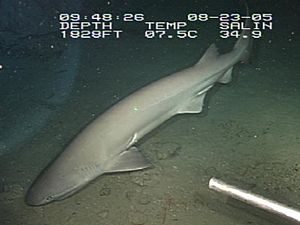
The prickly shark is a slow swimmer. It has been seen hovering just above the sea floor. Studies show that these sharks move up and down in the water each day. During the day, they are not active. They rest in safe spots near the sea floor in deep water. At dusk, they become active. They swim towards the coast and higher up into the water. This movement is probably to find schooling fish to eat.
Individual sharks usually stay in a small area. Their home range is no more than 2.2 square kilometers (0.85 square miles). In Monterey Canyon, prickly sharks often gather in groups of more than thirty.
The shape of the prickly shark's mouth suggests it sucks in its prey. It eats many different kinds of fish that live near the bottom or in open water. These include hake, flounders, rockfishes, lingcod, mackerel, and herring. They also eat other sharks like spiny dogfish and young bluntnose sixgill sharks. Octopuses and squid are also part of their diet.
Young prickly sharks can be eaten by bluntnose sixgill sharks. But adult prickly sharks probably have few enemies. Female prickly sharks give birth to live young. The babies grow inside the mother, getting food from a yolk sac. Only one pregnant female has been found, and she had 114 embryos. This is one of the largest litters known for any shark! The young sharks are probably less than 40 centimeters (16 inches) long when they are born. Males become adults when they are about 2 meters (6.6 feet) long. Females become adults when they are about 2.5 to 3 meters (8.2 to 9.8 feet) long.
Prickly Sharks and Humans
Prickly sharks are not aggressive towards humans. Divers have found that these sharks either let people get close or swim away.
Sometimes, prickly sharks are caught by accident by fishing boats. This is called bycatch. They are caught in nets or on fishing lines. They are not very valuable for food because their meat is soft.
Conservation Status
The International Union for Conservation of Nature (IUCN) has listed the prickly shark as "Data Deficient". This means there is not enough information to know how many prickly sharks there are. Their known locations are spread out, and deepwater fishing is growing. This could be a threat to their population. In New Zealand, the Department of Conservation also lists the prickly shark as "At Risk – Naturally Uncommon."



